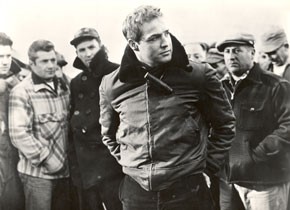Elia Kazan: Man on a Tightrope
February 18 to March 4, 2010
Elia Kazan was one of the most admired and controversial directors of American postwar cinema and theatre. As one of the co-founders of New York’s Actors Studio Kazan brought a new style of acting to the screen, influenced by the Stanislavsky method. Marlon Brando’s vivid and intense portrayals in Kazan’s classics, A Streetcar Named Desire (1951) and On the Waterfront (1954), are particularly famous examples of this “revolutionary” moment in U.S. film history which established a new generation of American performers.
In between those films the director himself delivered a performance that overshadowed his entire career: in 1952, at the height of Senator Joe McCarthy’s anti-communist witch hunts, the influential ex-communist Kazan cooperated with the House Un-American Activities Committee and named eight colleagues – a betrayal that still fueled resentment in 1999 when Kazan was awarded an Honorary Oscar. “What I’d done was correct,” he wrote in his autobiography, “but was it right?” This issue – the theme of betrayal – shapes many Kazan films after 1952. At the same time, these works bear witness to a growing cinematic expression, culminating in the lyrical masterpieces Wild River (1960) and Splendor in the Grass (1961), which in their unruly passion can be seen as harbingers of the New Hollywood. With the dark, independently financed The Visitors (1972, based on his son’s screenplay), Kazan returned once more to the subject of betrayal, this time against the backdrop of the Vietnam War.
Despite his successes, Kazan always felt like an outsider. The son of Anatolian Greeks, Elia Kazancioğlu was born in Istanbul in 1909 and came to New York a few years later with his family. Kazan’s most personal film, America, America (1963) presents the emigration of his uncle as the American (Immigrant) Dream. Kazan himself dreamt about film. After his studies he joined an independent left-wing theatre company in New York, the Group Theater, starting out as an actor but soon turning into a leading Broadway director. His pioneering stage creations include the original productions of Thornton Wilder’s Skin of Our Teeth, Arthur Miller’s Death of a Salesman and Tennessee Williams’ A Streetcar Named Desire.
1945 brought the long-awaited phone call from Hollywood: Kazan made his film debut with the coming-of-age story, A Tree Grows in Brooklyn. Underrated for many years, the film today is appreciated as one of his best. This was followed by studio contract work in between stage triumphs: a few toothless message movies, but also two thrillers in which Kazan was able to film on location for the first time. His film adaptation of A Streetcar Named Desire still strove for a chamber play look, but later on, the atmospheric use of locations would become a key element of his style.
Like the recurring conflicts between generations in his films, the interplay between natural scenery and stage sets is typical of the ambivalence of Kazan’s art. This also manifests in the clash between baroque cinematic effects and theatrical methods – or in the contradiction between his affirmations of the “dream factory” and his longing for change. This dichotomy is literally tangible: in his preference for over-the-top “hothouse” acting, in his penchant for controversial subjects, and in the cavalcade of fresh faces that would renew Cinema – James Dean in East of Eden (1955), Carroll Baker and Eli Wallach in the once-scandalous Baby Doll (1956), Lee Remick in Wild River or Warren Beatty in Splendor in the Grass. With his mix of the old and the new Kazan helped usher out the Hollywood studio system.
Kazan’s many balancing acts made him a Man on a Tightrope – the title of his 1953 film which can be understood as an attempt to prove his “good, anti-communist” stance right after the McCarthy hearings. In a characteristic denial, Kazan later claimed it was Gerd Oswald, and not himself, who directed the bulk of this film.
The Film Museum will screen a selection of Elia Kazan’s work, including three short films made in the pre-1945 context of left-wing artists groups in New York. His screen tests with James Dean and the 1982 documentary, Elia Kazan: An Outsider, will also be shown.
